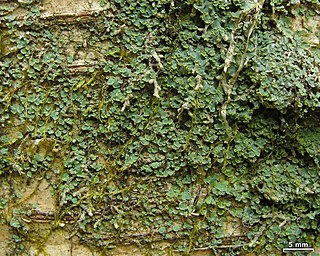Related Research Articles
The Amorphothecaceae are a family of fungi in the division Ascomycota. This family can not yet be taxonomically classified in any of the ascomycetous classes and orders with any degree of certainty. It contains the single genus Amorphotheca.
The Epigloeaceae are a family of fungi in the Ascomycota phylum. This family can not yet be taxonomically classified in any of the ascomycetous classes and orders with any degree of certainty. It contains the single genus Epigloea.
The Microcaliciaceae are a family of fungi in the Ascomycota phylum. This family can not yet be taxonomically classified in any of the ascomycetous classes and orders with any degree of certainty. It contains the single genus Microcalicium.
Apiotypa is a genus of fungi in the Ascomycota phylum. The relationship of this taxon to other taxa within the phylum is unknown, and it has not yet been placed with certainty into any class, order, or family. This is a monotypic genus, containing the single species Apiotypa philippinensis.
Argentinomyces is a genus of fungi in the Ascomycota phylum. The relationship of this taxon to other taxa within the phylum is unknown, and it has not yet been placed with certainty into any class, order, or family. This is a monotypic genus, containing the single species Argentinomyces naviculisporus.
Ascoxyta is a genus of fungi in the Ascomycota phylum. The relationship of this taxon to other taxa within the phylum is unknown, and it has not yet been placed with certainty into any class, order, or family. This is a monotypic genus, containing the single species Ascoxyta quercina.
Cladosphaera is a genus of fungi in the Ascomycota phylum. The relationship of this taxon to other taxa within the phylum is unknown, and it has not yet been placed with certainty into any class, order, or family. This is a monotypic genus, containing the single species Cladosphaera cespitosa.
Diehliomyces is a genus of fungi in the Ascomycota phylum. The relationship of this taxon to other taxa within the phylum is unknown, and it has not yet been placed with certainty into any class, order, or family. This is a monotypic genus, containing the single species Diehliomyces microsporus.
Enduria is a genus of fungi in the Ascomycota phylum. The relationship of this taxon to other taxa within the phylum is unknown, and it has not yet been placed with certainty into any class, order, or family. This is a monotypic genus, containing the single species Enduria ranaria.
Harmandiana is a fungal genus in the division Ascomycota. The relationship of this taxon to other taxa within the phylum is unknown, and it has not yet been placed with certainty into any class, order, or family. This is a monotypic genus, containing the single species Harmandiana vouauxii.
Leucoconiella is a genus of fungi in the Ascomycota phylum. The relationship of this taxon to other taxa within the phylum is unknown, and it has not yet been placed with certainty into any class, order, or family. This is a monotypic genus, containing the single species Leucoconiella paraguayensis.
Lichenopeziza is a genus of fungi in the Ascomycota phylum. The relationship of this taxon to other taxa within the phylum is unknown, and it has not yet been placed with certainty into any class, order, or family. This is a monotypic genus, containing the single species Lichenopeziza bryophile.
Ludwigomyces is a genus of fungi in the Ascomycota phylum. The relationship of this taxon to other taxa within the phylum is unknown, and it has not yet been placed with certainty into any class, order, or family. This is a monotypic genus, containing the single species Ludwigomyces parasiticus.

Normandina is a genus of fungi in the Ascomycota phylum. The relationship of this taxon to other taxa within the phylum is unknown, and it has not yet been placed with certainty into any class, order, or family.
Phthora is a genus of fungi in the Ascomycota phylum. The relationship of this taxon to other taxa within the phylum is unknown, and it has not yet been placed with certainty into any class, order, or family. This is a monotypic genus, containing the single species Phthora vastatrix.
Phylloporina is a genus of fungi in the Ascomycota phylum. The relationship of this taxon to other taxa within the phylum is unknown, and it has not yet been placed with certainty into any class, order, or family.
Porosphaera is a genus of fungi in the Ascomycota phylum. The relationship of this taxon to other taxa within the phylum is unknown, and it has not yet been placed with certainty into any class, order, or family.
Pseudoperitheca is a genus of fungi in the Ascomycota phylum. The relationship of this taxon to other taxa within the phylum is unknown, and it has not yet been placed with certainty into any class, order, or family. This is a monotypic genus, containing the single species Pseudoperitheca murmanica.
Stellifraga is a genus of fungi in the Ascomycota phylum. The relationship of this taxon to other taxa within the phylum is unknown, and it has not yet been placed with certainty into any class, order, or family. This is a monotypic genus, containing the single species Stellifraga cladoniicola.
Xenomyxa is a genus of fungi in the Ascomycota phylum. The relationship of this taxon to other taxa within the phylum is unknown, and it has not yet been placed with certainty into any class, order, or family. This is a monotypic genus, containing the single species Xenomyxa disseminata.
References
- ↑ Lumbsch TH, Huhndorf SM (December 2007). "Outline of Ascomycota – 2007". Myconet. Chicago, USA: The Field Museum, Department of Botany. 13: 1–58.
| This Ascomycota-related article is a stub. You can help Wikipedia by expanding it. |